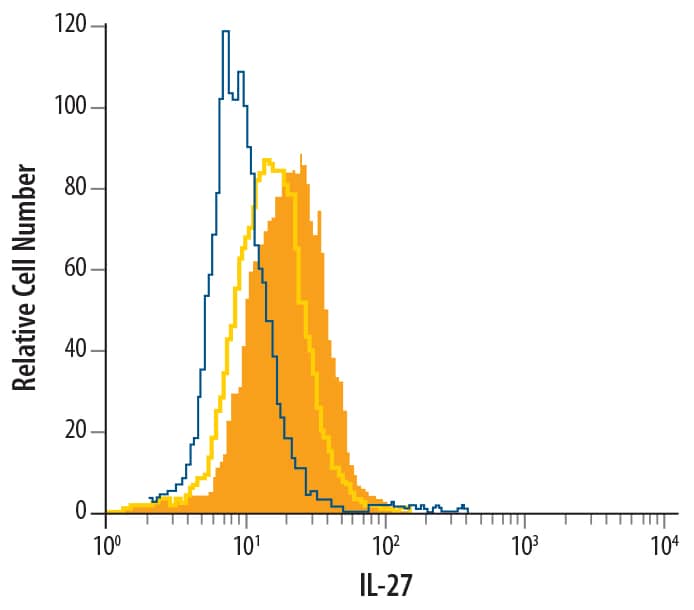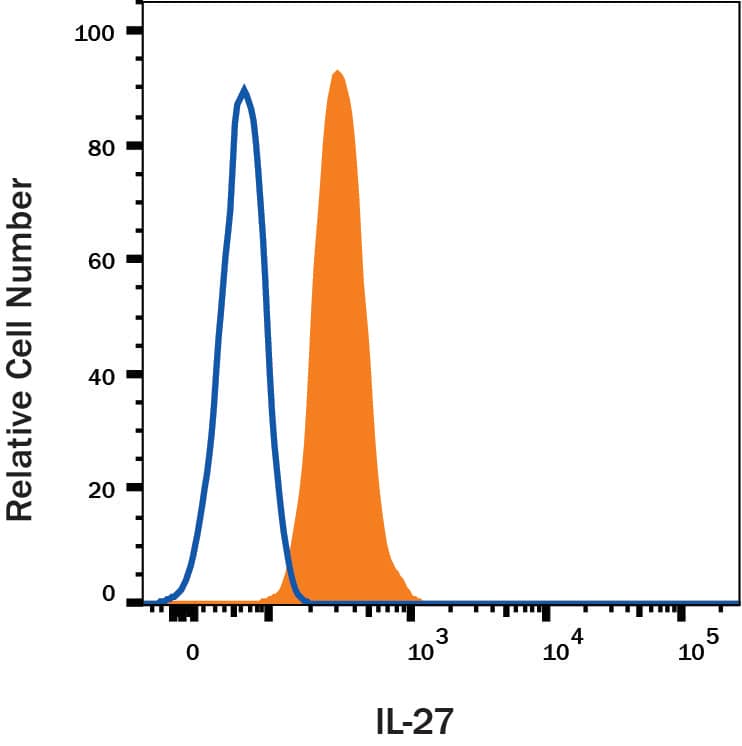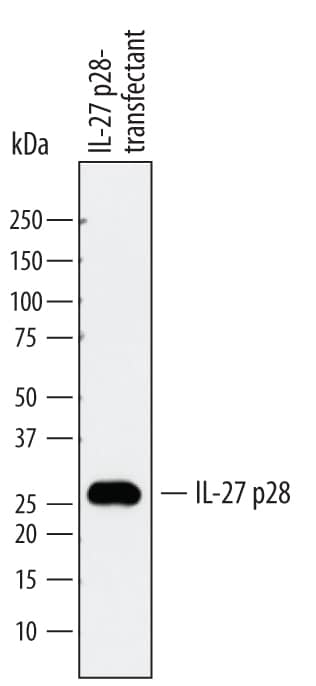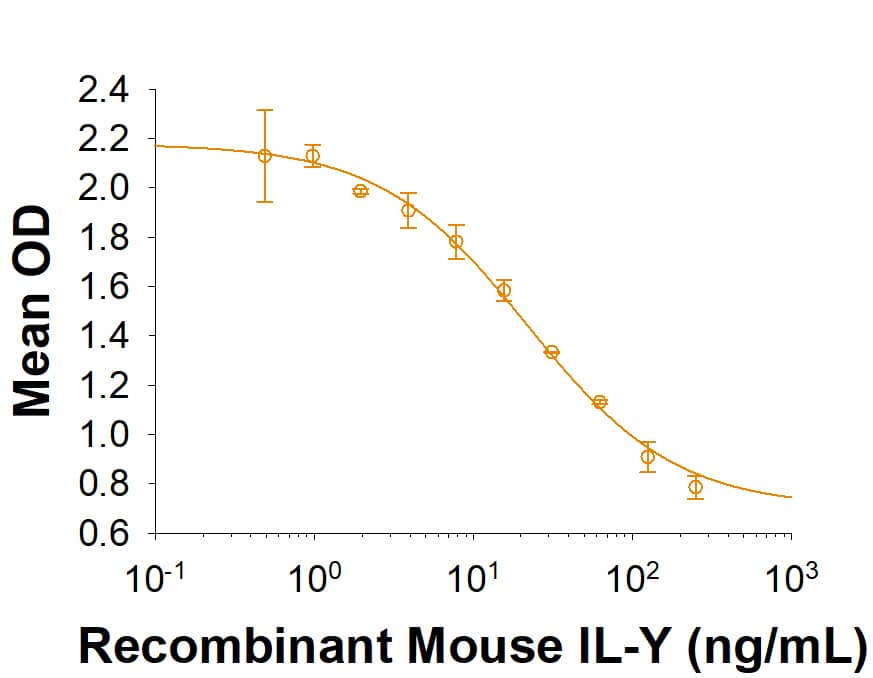IL-27 p28/IL-30 Products
Interleukin-27 (IL-27) is a heterodimeric group 2 receptor ligand molecule that belongs to the IL-6/IL-12 family of long type I cytokines. It is composed of EBI3 (EBV-induced gene 3), a 34 kDa glycoprotein that is related to the p40 subunit of IL-12 and IL-23, and p28, the 28 kDa glycoprotein that is related to the p35 chain of IL-12). The human EBI3 gene encodes a 229 amino acid (aa) precursor that contains a 20 aa signal peptide and 209 aa mature protein. The mature region contains two potential N-linked glycosylation sites, two fibronectin type III domains, and two pairs of conserved cysteine residues with a WSxWS-like motif that places the IL-27 molecule in the hematopoietin receptor family. Although p40, the EBI3 counterpart in IL-12, is known to form homodimers, there is no evidence to date that EBI3 also homodimerizes.
Human EBI3 is 61% aa identical to mouse EBI3. The human p28 gene encodes a 243 aa precursor that contains a 28 aa signal sequence and 215 aa mature region. The mature region is characterized by the presence of four α-helices, placing it in the IL-6 family of helical cytokines. Human p28 is 74% aa identical to mouse p28. IL-27 is expressed by monocytes, endothelial cells and dendritic cells. IL-27 binds to and signals through a heterodimeric receptor complex composed of WSX-1 (TCCR) and gp130. Evidence suggests IL-27 interacts only with WSX-1. IL-27 has both anti- and pro-inflammatory properties. As an anti-inflammatory, IL-27 seems to induce a general negative feedback program that limits T and NK-T cell activity. At the onset of infection, IL-27 induces an IL-12 receptor on naïve CD4+ T cells, making them susceptible to subsequent IL-12 activity (and possible Th1 development).
41 results for "IL-27 p28/IL-30" in Products
41 results for "IL-27 p28/IL-30" in Products
IL-27 p28/IL-30 Products
Interleukin-27 (IL-27) is a heterodimeric group 2 receptor ligand molecule that belongs to the IL-6/IL-12 family of long type I cytokines. It is composed of EBI3 (EBV-induced gene 3), a 34 kDa glycoprotein that is related to the p40 subunit of IL-12 and IL-23, and p28, the 28 kDa glycoprotein that is related to the p35 chain of IL-12). The human EBI3 gene encodes a 229 amino acid (aa) precursor that contains a 20 aa signal peptide and 209 aa mature protein. The mature region contains two potential N-linked glycosylation sites, two fibronectin type III domains, and two pairs of conserved cysteine residues with a WSxWS-like motif that places the IL-27 molecule in the hematopoietin receptor family. Although p40, the EBI3 counterpart in IL-12, is known to form homodimers, there is no evidence to date that EBI3 also homodimerizes.
Human EBI3 is 61% aa identical to mouse EBI3. The human p28 gene encodes a 243 aa precursor that contains a 28 aa signal sequence and 215 aa mature region. The mature region is characterized by the presence of four α-helices, placing it in the IL-6 family of helical cytokines. Human p28 is 74% aa identical to mouse p28. IL-27 is expressed by monocytes, endothelial cells and dendritic cells. IL-27 binds to and signals through a heterodimeric receptor complex composed of WSX-1 (TCCR) and gp130. Evidence suggests IL-27 interacts only with WSX-1. IL-27 has both anti- and pro-inflammatory properties. As an anti-inflammatory, IL-27 seems to induce a general negative feedback program that limits T and NK-T cell activity. At the onset of infection, IL-27 induces an IL-12 receptor on naïve CD4+ T cells, making them susceptible to subsequent IL-12 activity (and possible Th1 development).
| Sensitivity: | 4.7 pg/mL |
| Applications: | ELISA |
| Assay Range: | 7.8 - 500 pg/mL (Cell Culture Supernates, Serum, EDTA Plasma, Heparin Plasma) |
| Reactivity: | Mouse |
| Details: | Goat IgG Polyclonal |
| Applications: | WB, IHC, Neut |
Contains 4 membranes-each spotted in duplicate with 111 different cytokine antibodies
| Assay Range: | 15.6 - 1,000 pg/mL |
| Applications: | ELISA |
| Source: | NS0 |
| Accession #: | Q8K3I6 |
| Applications: | BA |
| Reactivity: | Mouse |
| Details: | Rat IgG2b Monoclonal Clone #234205 |
| Applications: | WB, CyTOF-ready, ICFlow |
| Reactivity: | Mouse |
| Details: | Goat IgG Polyclonal |
| Applications: | WB |
| Reactivity: | Mouse |
| Details: | Rat IgG2b Monoclonal Clone #234205 |
| Applications: | ICFlow |
| Reactivity: | Mouse |
| Details: | Rat IgG2b Monoclonal Clone #234205 |
| Applications: | ICFlow |
| Reactivity: | Mouse |
| Details: | Rat IgG2b Monoclonal Clone #744015 |
| Applications: | WB |
| Reactivity: | Mouse |
| Details: | Rat IgG2b Monoclonal Clone #234205 |
| Applications: | ICFlow |
| Reactivity: | Mouse |
| Details: | Rat IgG2b Monoclonal Clone #234205 |
| Applications: | ICFlow |
| Reactivity: | Mouse |
| Details: | Rat IgG2b Monoclonal Clone #234205 |
| Applications: | ICFlow |
| Reactivity: | Mouse |
| Details: | Rat IgG2b Monoclonal Clone #234205 |
| Applications: | ICFlow |
| Reactivity: | Mouse |
| Details: | Rat IgG2B Monoclonal Clone #234205 |
| Applications: | WB, Flow, CyTOF-ready |
| Reactivity: | Mouse |
| Details: | Rat IgG2B Monoclonal Clone #234205 |
| Applications: | WB, Flow, CyTOF-ready |
| Reactivity: | Mouse |
| Details: | Rat IgG2b Monoclonal Clone #234205 |
| Applications: | ICFlow |
| Reactivity: | Mouse |
| Details: | Rat IgG2b Monoclonal Clone #234205 |
| Applications: | ICFlow |
| Source: | NS0 |
| Accession #: | P43432, Q8K3I6 |
| Applications: | BA |
| Reactivity: | Mouse |
| Details: | Rat IgG2B Monoclonal Clone #234205 |
| Applications: | WB, Flow, CyTOF-ready |
| Reactivity: | Mouse |
| Details: | Rat IgG2B Monoclonal Clone #234205 |
| Applications: | WB, Flow, CyTOF-ready |
| Reactivity: | Mouse |
| Details: | Rat IgG2B Monoclonal Clone #234205 |
| Applications: | WB, Flow, CyTOF-ready |
| Reactivity: | Mouse |
| Details: | Rat IgG2B Monoclonal Clone #234205 |
| Applications: | WB, Flow, CyTOF-ready |
| Reactivity: | Mouse |
| Details: | Rat IgG2B Monoclonal Clone #234205 |
| Applications: | WB, Flow, CyTOF-ready |
| Reactivity: | Mouse |
| Details: | Rat IgG2B Monoclonal Clone #234205 |
| Applications: | WB, Flow, CyTOF-ready |











